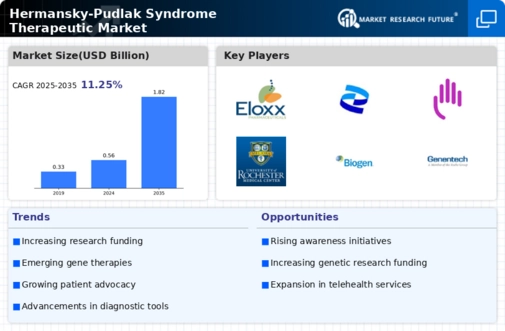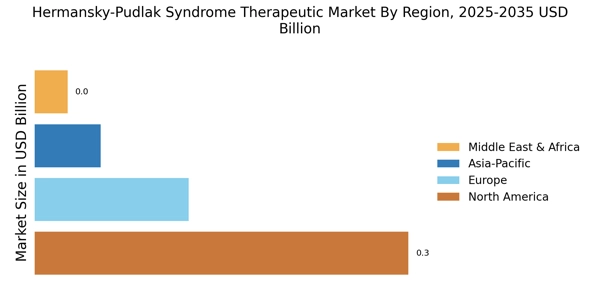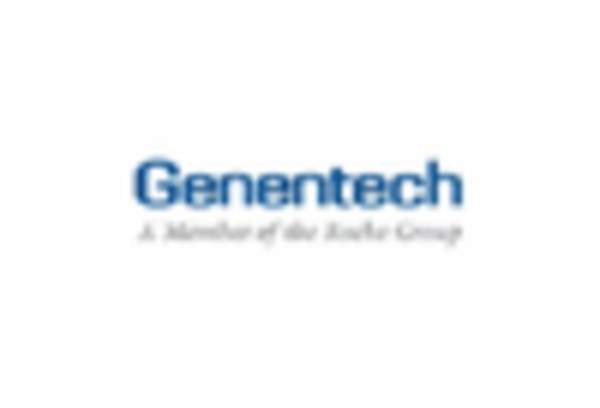Advancements in Genetic Research
Advancements in genetic research play a crucial role in shaping the Hermansky-Pudlak Syndrome Therapeutic Market. The identification of specific genetic mutations associated with HPS has paved the way for targeted therapies and personalized medicine approaches. As researchers continue to unravel the genetic underpinnings of HPS, there is a growing potential for developing innovative treatments that address the root causes of the syndrome. This progress not only enhances the understanding of HPS but also fosters collaboration between academic institutions and pharmaceutical companies, leading to the creation of novel therapeutic options. Furthermore, the integration of genetic testing into clinical practice may facilitate earlier diagnosis and intervention, ultimately improving patient outcomes. Thus, the advancements in genetic research are likely to drive the Hermansky-Pudlak Syndrome Therapeutic Market forward, as new therapies emerge from these scientific breakthroughs.
Growing Awareness and Education Initiatives
Growing awareness and education initiatives surrounding Hermansky-Pudlak Syndrome are pivotal in shaping the Hermansky-Pudlak Syndrome Therapeutic Market. Increased efforts by advocacy groups and healthcare organizations to educate both the public and medical professionals about HPS have led to improved recognition and diagnosis of the syndrome. As awareness rises, more patients are likely to seek medical attention, thereby increasing the demand for effective therapies. Educational campaigns also emphasize the importance of early intervention, which can significantly impact patient outcomes. Furthermore, as healthcare providers become more informed about HPS, they may be more inclined to explore and prescribe available treatment options. This heightened awareness and education are expected to drive the Hermansky-Pudlak Syndrome Therapeutic Market, as more individuals are diagnosed and treated for this rare condition.
Regulatory Support for Innovative Therapies
Regulatory support for innovative therapies is a critical driver of the Hermansky-Pudlak Syndrome Therapeutic Market. Regulatory agencies are increasingly recognizing the need for expedited pathways for the approval of treatments targeting rare diseases like HPS. Initiatives such as fast track designations and breakthrough therapy designations facilitate the development and review of new therapies, allowing for quicker access to patients in need. This supportive regulatory environment encourages pharmaceutical companies to invest in research and development for HPS treatments, as the potential for rapid market entry becomes more feasible. Additionally, the emphasis on patient-centric approaches in regulatory frameworks aligns with the goals of improving outcomes for individuals with HPS. As a result, the Hermansky-Pudlak Syndrome Therapeutic Market is likely to experience growth driven by the favorable regulatory landscape that promotes innovation and expedites access to new therapies.
Increased Investment in Rare Disease Research
The surge in investment directed towards rare disease research significantly influences the Hermansky-Pudlak Syndrome Therapeutic Market. With a growing recognition of the unmet medical needs associated with rare conditions like HPS, funding from both public and private sectors has increased. This financial support enables researchers to explore innovative therapeutic avenues and develop effective treatments tailored to HPS patients. In recent years, initiatives such as orphan drug designations and grants have incentivized pharmaceutical companies to focus on rare diseases, including HPS. As a result, the Hermansky-Pudlak Syndrome Therapeutic Market is likely to benefit from a pipeline of new therapies that emerge from this heightened investment landscape. The commitment to addressing rare diseases not only enhances treatment options but also raises awareness about HPS, potentially leading to improved patient care and outcomes.
Rising Prevalence of Hermansky-Pudlak Syndrome
The increasing prevalence of Hermansky-Pudlak Syndrome (HPS) is a notable driver for the Hermansky-Pudlak Syndrome Therapeutic Market. Recent estimates suggest that HPS affects approximately 1 in 500,000 individuals, with certain populations exhibiting higher rates. This growing patient population necessitates the development of effective therapeutic options, thereby stimulating market growth. As awareness of HPS expands, healthcare providers are more likely to diagnose and treat affected individuals, further contributing to the demand for specialized therapies. The rising prevalence not only highlights the need for innovative treatments but also encourages pharmaceutical companies to invest in research and development, potentially leading to breakthroughs in HPS management. Consequently, the Hermansky-Pudlak Syndrome Therapeutic Market is poised for expansion as stakeholders respond to the increasing number of diagnosed cases.


















Leave a Comment